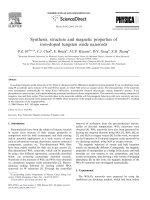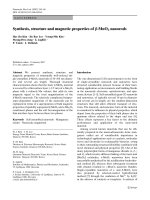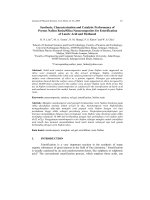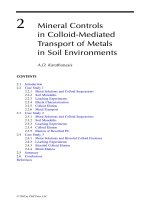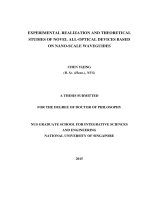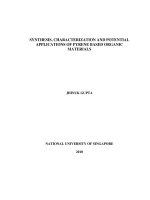SYNTHESIS, STRUCTURE AND CATALYTIC APPLICATION OF NOVEL CARBENE COMPLEXES WITH BENZOTHIAZOLIN 2 YLIDENE LIGANDS 4
Bạn đang xem bản rút gọn của tài liệu. Xem và tải ngay bản đầy đủ của tài liệu tại đây (48.18 KB, 4 trang )
Chapter Four Conclusion and Summary
209
Chapter Four
Conclusion and Summary
4.1 Conclusion and Summary
N,S-heterocyclic carbene complexes of Pd(II) and their catalytic activities
have been studied in this work. The results are presented and discussed in Chapter
Two, Section 2.1 to 2.12.
In Chapter Two, Part I, Section 2.1, the synthesis of A-D under solvent-free
conditions is discussed. The synthesis and coordination chemistry of monocarbene
and biscarbene Pd(II)-NSHC complexes as well as dinuclear Pd(II)-NSHC complexes
are described in Chapter Two, Section 2.2. Complexes 2.1 and 2.2(a) are synthesized
in CH
3
CN and DMSO and formed as biscarbene Pd(II) and dinuclear Pd(II)
complexes respectively. The mononuclear and solvated monocarbene Pd(II)-
complexes (2.3 and 2.4) are obtained from the bridge cleavage reaction of complex
2.2 with CH
3
CN and DMF. These complexes are shown to be catalytically active in
the Mizoroki-Heck reaction. The reaction of compound B and Pd(OAc)
2
giving two
major complexes cis-[PdBr
2
(NSHC)
2
] (cis-2.5) and trans-[PdBr
2
(NSHC)
2
] (trans-2.5)
as well as two minor side products of monocarbene complexes [PdBr
2
(NSHC)] (2.6)
and trans-[PdBr
2
(benzothiazole-ĸN)(NSHC)] (2.7) is discussed in Chapter Two,
Section 2.4. The mixed dicarboxylato-bis(carbene) complex cis-
[Pd(O
2
CCF
3
)
2
(NSHC)
2
] (2.8) is obtained from ligand exchange of cis-2.5 with
AgO
2
CCF
3
. The catalytic activity of complexes cis-2.5, trans-2.5 and 2.8 as well as
an in situ mixture of Pd(OAc)
2
and compound B are studied in the Suzuki–Miyaura
Chapter Four Conclusion and Summary
210
coupling of aryl bromides and activated aryl chlorides and give good conversions of
diaryl products. Complexes 2.1-2.4, cis-2.5, 2.6-2.7 are structurally characterized.
Chapter Two, Part II, Sections 2.4-2.8 discusses the synthesis and
characterization of a range of mixed-NSHC-L Pd(II) complexes (L = phosphine,
aromatic N-heterocycles, pyridyl and azole ligands (2.9-2.27)). They are obtained
from bridge cleavage of dinuclear NSHC complexes of type [PdBr
2
(NSHC)]
2
(2.2(a)-
2.2(b) and 2.17) complexes with different nucleophilic ligands. Complexes 2.9-2.16
are active in the Suzuki–Miyaura coupling reactions of selected aryl bromides.
Complexes 2.22-2.27 catalyze sp
2
-sp
3
cross-coupling of fluoroaryl halides with
arylboronic acid giving diarylmethanes with good yields and high turnovers. Five
Pd(II) complexes with N,N-benzimidazolin-2-ylidene are prepared and characterized
by X-ray single-crystal diffraction analysis. These complexes are more active in the
Suzuki-Miyaura coupling of selected aryl bromides than their N,S-heterocyclic
carbene (NSHC) counterparts.
The
13
C
carbene
NMR signals of Pd(II)-complexes bearing 3-
benzylbenzothiazolin-2-ylidene are given in Fig. 4.1. The
13
C
carbene
NMR of Pd(II)-
biscarbene complex 2.1 resonances at 203.8 ppm. When different donor ligands are
coordinated to the Pd(II)-NSHC dinuclear complex 2.2(a), the
13
C
carbene
chemical
shifts of these mix-NSHC-ligand Pd(II) complexes vary expectedly. An upfield shift
is observed with coordinating solvents or aromatic N-heterocycle ligands (less donor
ability co-ligands) while a downfield shift is observed for phosphine ligands (more
donor ability co-ligands).
Chapter Four Conclusion and Summary
211
Fig. 4.1
13
C
carbene
NMR signals of Pd(II)-complexes bearing the 3-benzylbenzothiazolin-2-
ylidene ligand.
Chapter Two, Part III, Section 2.10 discusses some unexpected findings on the
reaction of benzothiazolium salts with Ag
2
O. Some oxidation and cyclization
products instead of the expected benzothiazolin-2-ylidenes of Ag(I) are isolated.
Single-crystal X-ray studies of the ten-membered heteromacrocycle 1,2,5,8-
dithiadiazecine-6,7-diones (2.34(a)) and the complex salt of 3-
isopropylbenzothiazolium
with polymeric [Ag
2
I
4
]
n
2n-
dianion (2.38(a)) have been
conducted. The silver-carbene transfer route may not be suitable for metal
benzothiazolin-2-ylidene syntheses.
The synthesis and coordination of mixed-NSHC/NNHC-cyclometallated Pt(II)
complexes are presented in Chapter Two, Part III, Section 2.11. X-ray single-crystal
diffraction reveals the NSHC ligand to be trans to the nitrogen in 2-phenylpyridine
(2.39(a) and 2.39(b)) while the NNHC ligand is trans to the carbon in 2-
phenylpyridine (2.40). These compounds are essentially isostructural but differ in the
N
S
H
Br
S
N
N
S
Pd
Br Br
N
S
Pd
Br
Br
P
N
N
S
Pd
Br
Br
P
208.7
208.4
207.7
203.8 197.5
195.9
195.8
195.7
191.5
165.1
N
S
Pd N
Br
Br
S
N
S
Pd NCCH
3
Br
Br
N
S
Pd
Br
Br
P
N
S
Pd
Br
Br
DMF
N
S
Pd
Br
Br
Pd
Br
S
N
Br
N
N
N
S
Pd
N
Br
Br
13
C NMR
(ppm)
Chapter Four Conclusion and Summary
212
phenyl ring orientation and significantly on the inter-planar angle between the Pt
coordination and the heterocycle planes.
Finally, the five- and six-membered fused-ring imidazolium, thiazolium and
benzimidazolium salts (2.42 (f, g, l, n, p)) are obtained from the catalytic Ni(0)/Ni(II)
reaction starting from alkenyl-substituted azolium salts. A catalytically active Ni(II)-
H species generated from the oxidative addition of azolium salt to Ni(0) is formed.
The Pt(II)-H complex 2.43 is formed similarly from the reaction of Pt(0) and
imidazolium salt (2.41(f)) and has been observed by
1
H NMR spectroscopy.
